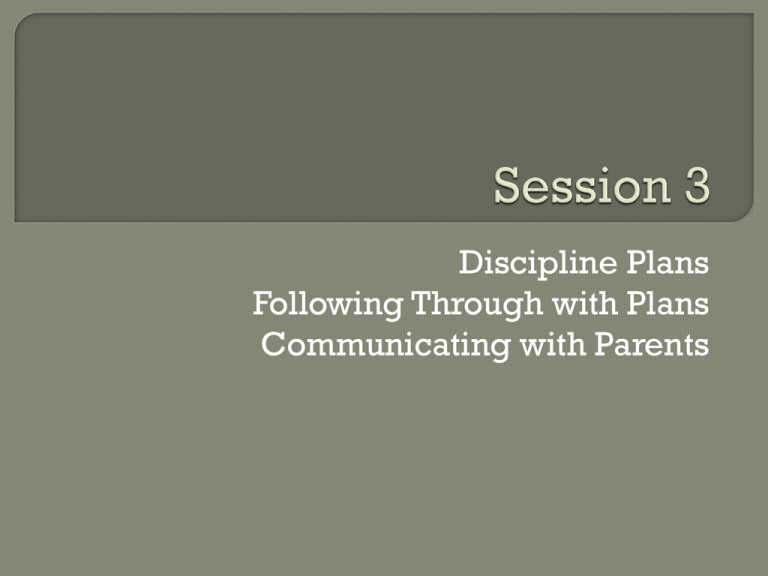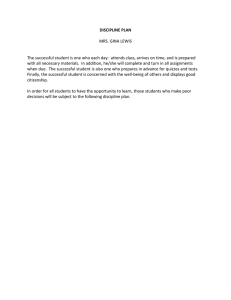Session 3 PowerPoint
advertisement

Discipline Plans Following Through with Plans Communicating with Parents Do a first read of the Tips for Effective Discipline with High School Students article Highlight what you think are the most important points Contest! With your table group unscramble the words or concepts that relate to our session’s next topic on the handout Be sure to note spaces and hyphens You have 4 minutes The team with the highest number unscrambled wins! Topic: Discipline in secondary classes Do: Examine and discuss the challenges of successfully implementing discipline procedures at the high school level LOT: Analyzing On your whiteboard, write down one thing that you think a teacher absolutely must do to have a classroom with as few discipline problems as possible other than building relationships with students (we already established that – what else should be done?). Written World by Harry Wong renowned teacher and lecturer with 35 years of classroom teaching The number 1 problem in the classroom is not discipline: it is the lack or procedures and routines. Think back to our first session when we talked about the classroom expectations we have for our students to follow Respect peers, teacher, and school property Be present, on time, alert, and ready to work Participate fully, trying your hardest Turn in assignments on time Take care of personal needs prior to class time Calling parents at the beginning of the year with a positive comment may help to deter future problems. On the half sheet provided, write down up to six “non-negotiable expectations” that you would have for your students. MPS has District Guidelines for Student Behavior • See handout – very broad guidelines • Most schools have campus-wide policies – Did you bring yours? • If not, see Red Mountain’s on flip side of MPS Guidelines - be sure your policies are consistent with your school’s! Provide students with paper copies of your expectations, and consequences for noncompliance Include this information in the beginning of the year parent letter so they acknowledge your expectations – this would be a good time to get their email addresses Post expectations on classroom/lab walls Let’s use the checklist to see if your letters meet all criteria When you send the expectations home to parents: Provide Put second copy for them to keep it on your website for future reference Independently complete a second read of the article, Tips for Effective Discipline with High School Students Put stars by the top three that you think are most critical to insuring that students meet your expectations Discuss group your “top threes” with your table On the half sheet provided, describe what you personally do to address your top one or two tips for effective student discipline from the article Yet still there will be instances when students are inappropriate and must receive consequences Be objective – most times misbehavior is a result of something else going on in students’ lives that you may never know about – don’t take things personally if you have not done anything to provoke them Regardless of the outcome, you will lose Separate the student from the problem Let them know you care about them Do not embarrass the student Pick battles wisely and carefully Make expectations clear and logical Give student a chance to do the right thing Remain optimistic Be fair at all cost Make sure the kid understands what the final word was about next step (the bottom line) Students should know what will happen if they do not live up to your expectations Teachers MUST follow through with the consequences for infractions Parents need to be informed if disciplinary action takes place Keep administrative referrals to a minimum Do not refer to administrator unless the parents have heard what happened from you first Be as objective and calm as possible when relaying the situation to parents It is not fair to have an administrator try to tell the story “second hand” Be sensitive to timing Introduce Be yourself and what you teach as positive and objective as you can Call before the situation is extreme Provide Follow ideas for solutions through and follow up Objectively record what has transpired and what you have done about it If you have tried unsuccessfully to reach parents, document times and dates Even if your impression is that parents “don’t care” or “aren’t going to do anything about it” the calls must be made and documented before taking the next step (administrative referral) 1st offense – teacher/student conference 2nd offense – teacher/student conference plus parent contact 3rd offense – administrative referral Remember to keep conversations with disruptive or disobedient students as private as possible Read through all seven scenarios Choose two for which to write a response Find someone who answered one of the same prompts. Compare/Discuss Be prepared to share with the group! Tell the students that things aren’t working the way things are going, and that you need them to help solve the problem Describe the changes you’ve planned INSIST on following the new procedures Be consistent! Post the new expectations Prepare Prepare Prepare 3 ideas discussed in this session that are worth considering further 2 reasons to stay calm when dealing with disruptive students or disagreeable parents 1 way to handle students who want to have a public confrontation with the teacher You will be getting a link for the evaluation for this class. Please complete. Take your certificates. ADE certificates will be issued after visits are completed The next class offered will be Student Engagement and Questioning Strategies starting the 3rd Monday in October. We would love to have you join us. No pressure. Details will be sent to you as soon as it is on the ERO system.

